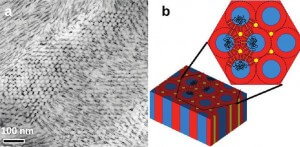The method could help stimulate the electronic and mechanical properties of materials containing polymers in the form of nanorods

A fast, simple and inexpensive method for preparing nanorods, which are semiconducting nanocrystals in the form of a rod - through independent organization into one-, two- and even three-dimensional macroscopic structures was developed by a team of researchers from the US Department of Energy. This method could enable a more efficient use of nanorods in solar cell applications, magnetic storage devices and various sensors. Also, the method could help in stimulating the electronic and mechanical properties of materials containing polymers in the form of nanorods.
The research team of polymer scientist Ting Xu from the University of California at Berkeley used block copolymers – long segments or “blocks” of one type of monomer linked to blocks of another type of monomer – as a substrate that directs the independent organization of nanorods to obtain complex structures and regular patterns. Block copolymers have a built-in ability to self-organize into well-defined arrays of nanostructures over macroscopic distances.
"Our method is a simple and versatile method for controlling the orientation of nanorods within block copolymers," explains the lead researcher. "By changing the morphology of the block copolymers and the chemical nature of the nanorods we are able to provide controlled self-assembly in nanorods and nanostructures based on them, structures that are essential for the production of optical and electronic devices." The research findings were published in the scientific journal Nano Letters.
Nanorods - material particles that are thousands of times smaller than the microtechnologies that exist today - exhibit optical, electronic and other properties that do not exist in macroscopic materials. However, in order to realize their great technological potential, the nanorods must organize themselves into complex structures and regulated arrays, similar to what nature achieves with the help of proteins.
The research group first employed block copolymers in this self-assembly effort in 2009, when they worked with spherical nanoparticles known as quantum dots. During this study, they attached quantum dots to block copolymers through an intermediary that was small adhesive molecules. In this study as well, the scientists used adhesive molecules, but this time in order to connect nanorods with supermolecules of block copolymers. A supermolecule is a group of molecules that behave as a single molecule capable of performing a defined set of functions.
"Supermolecules of a copolymer block organize independently and create a wide range of array morphologies with sizes of tens or a few nanometers," notes the lead researcher. "Thanks to this, these molecules provide an ideal structural framework for the collective organization of nanorods."
The researchers mixed nanorods into solutions of block copolymer supermolecules that form spherical, cylindrical, and layered microregions.
"We can easily produce a library of nanorod arrays that includes arrays of nanorods corresponding to block copolymers, continuous nanorod networks and nanorod clusters," notes the researcher. "Since the macroscopic orientation of the microarrays of block copolymers can be achieved in the raw solution as well as in thin layers by applying external fields, our method could open a window to an efficient path for the operation of nanorod arrays."
This new method could assist in the production of ordered arrays of macroscopically oriented nanorods together with adjustable distances between the individual nanorods - a morphology that could aid in the development of plasmonics components, which are materials with tremendous potential in the development of super-fast computers , very powerful optical microscopes and even the development of invisible fabrics. In addition, such arrays could increase the macroscopic properties of nanomaterials, such as electrical conductivity and material strength.
The group of scientists is now investigating the self-assembly of semiconductor nanocrystals in the form of cubes and quadrupedal structures, two shapes that have important application potential for the development of photovoltaic devices and other technologies.
The news about the study
